The Future of Stuyvesant Town & Peter Cooper Village
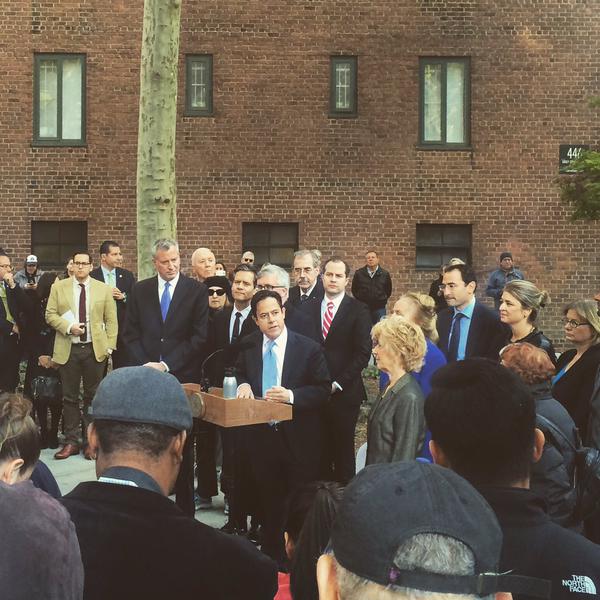
CM Garodnick, the author, announcing the ST/PCV deal (photo: @DanGarodnick)
Major real estate transactions in New York too often create uncertainty for tenants living in previously stable communities. We all know what typically happens: the deal is done, the tenants are displaced, money is made. This is the story that has played out in Stuyvesant Town and Peter Cooper Village (ST/PCV) since 2006, when MetLife sold ST/PCV to Tishman Speyer for a record-setting $5.4 billion and many feared for the future of New York City's last big bastion of affordable housing for middle class New Yorkers.
These concerns only increased after the sale, as Tishman Speyer tried to make good on its investment by raising rents and eliminating as many affordable units as possible, converting them to market rate. Tishman Speyer was unsuccessful in its effort, and in 2010, defaulted on its significant debt. The fate of ST/PCV was left up in the air, and the tenants were left dreading that the story would end the way most would expect, with another unscrupulous landlord trying to force them out.
After years of hard work and advocacy, including winning a class action lawsuit at the Court of Appeals, fighting and reversing mid-lease rent increases, and getting Fannie Mae and Freddie Mac to stay away from any deal that did not have our blessing -- we have finally succeeded in getting the community on a more stable path.
Earlier this week, CWCapital announced its sale of ST/PCV to the Blackstone Group and Ivanhoé Cambridge, in an agreement that will be the largest city-led affordable housing preservation deal in history -- and one that can serve as a model for other parts of the City.
As part of the negotiations with the tenants and Mayor de Blasio, Blackstone has committed to preserving 5,000 rent-stabilized units for the next generation of middle-class residents. Under this deal, tenants who are currently in rent-stabilized units will be protected by rent-stabilization laws for as long as they reside in their apartment, and they are further protected by the City's agreement, which restricts the rent that can be charged on 5,000 units for the next 20-25 years, giving the new owner little incentive to turn over the units. And that timeframe could be extended down the line (as has happened many times in Stuyvesant Town and Peter Cooper since the early 1970s), with new agreements between the owners and the City or State.
Blackstone has also agreed to cap rent increases on about 1,400 tenants affected by the Roberts case, whose below-market-rate units could have been immediately brought to the market when the J-51 property tax abatement expires in 2020.
As a co-founder of the Coalition Against Predatory Equity in Housing, it was also critical to me that the structure of the deal was one that did not create pressure to evict rent-stabilized tenants based on the debt load. In 2006, the new owner had overleveraged the deal to a significant degree -- they had borrowed 80 percent of the purchase price, and the rents did not at all support the debt burden. That meant that they needed to quickly raise rents to pay their debt. In today's framework, the cash flow on day one will more than support the debt, creating very little pressure on Blackstone to make any sudden changes, or go after tenants.
That is why this deal has earned my support. When an active and organized body meets with the political will at all levels of government, important things can happen. And at a time when too many tenants are being left on the sidelines, we have struck a deal that will lead to a more stable community for tenants both old and new, and for the City.
***
Dan Garodnick is a member of the New York City Council representing the fourth district, in Manhattan, which includes Stuyvesant Town and Peter Cooper Village. Garodnick has served on the Council since 2006. He is on Twitter @DanGarodnick.
***
Have an op-ed idea or submission for Gotham Gazette? E-mail editor Ben Max: This email address is being protected from spambots. You need JavaScript enabled to view it.
A More Cost-Effective Adult Homeless Services System
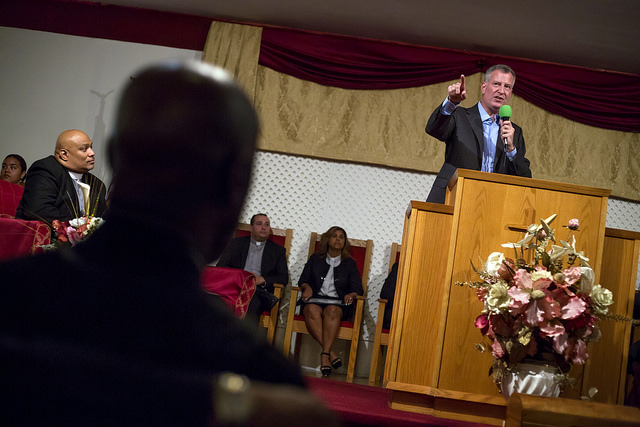
Mayor de Blasio (Ed Reed/Mayoral Photography Office)
Last week, the New York City Independent Budget Office published a fiscal brief -Albany Shifts the Burden: As the Cost for Sheltering the Homeless Rises, Federal & City Funds Are Increasingly Tapped- detailing the financing of city homeless shelters from 2007 to 2014. The brief sheds light on the imminent need for reform of the single adult homeless services system. It also provides a roadmap that the City and State should follow to address the issue in a cost-effective manner.
In particular, the IBO report illuminates the rising costs of sheltering single homeless adults. From 2007 to 2014, city shelter costs for the population more than doubled, rising from $196 million to $343 million (75 percent increase). Aghast to think, the financial cost of single adult homelessness in New York City is actually above $343 million, though.
As IBO acknowledges, $343 million is merely the cost to shelter those associated with the Department of Homeless Services. There is also the cost to shelter domestic violence victims, persons with HIV/AIDS, and runaway youth through the Human Resources Administration and Department of Youth and Community Development. In addition, there is the cost of outreach programs, drop-in centers, and respite beds ($35 million in 2014) to bring homeless individuals inside. There are also the public institutional costs of street homelessness: $40,000 per individual per year, as of 2012, according to former Housing and Urban Development Secretary Shaun Donovan.
The IBO brief also reveals the increasing financial share that New York City pays to shelter single homeless adults. State changes in funding rules have shifted single adult shelter costs from the State towards the City. In 2007, the City funded 53 percent ($104 million) of the single adult shelter cost. However, in 2014, the City funded 73 percent ($252 million).
The IBO brief recommends that since the City largely goes it alone in funding single adult shelters, it should focus on reducing the single adult census. As a nonprofit that has worked for forty years to provide this population a way home, Urban Pathways encourages the City and State to focus on the following.
Paramount is the City and State funding effective exit options. First and most important is a new supportive housing agreement, a NY/NY IV. The first three agreements were extremely successful in stably housing homeless adults. More than 86 percent of NY/ NY III tenants remained housed after one year. More than three-quarters of homeless individuals remained housed after two years. Supportive housing is also cost-effective. It costs significantly less per day than shelter ($55, as opposed to $78).
The second exit option is a more long-term and jointly-financed Living in Communities (LINC) rental subsidy program for homeless adults. Admirably, the City initiated, and is solely funding, several rental subsidies. It is unrealistic for the City to sustain this investment in the long term without a commitment of matching funds from the State and Federal governments.
Additionally, a more long-term, State- and City-financed rental subsidy may also appease currently resistant landlords, freeing up needed apartments. Right now, it is difficult to get landlords to accept the LINC voucher. They can get higher rents from other tenants, and they harbor concerns from the demise of the Work Advantage program.
Also important is that the City and State governments reassess the single adult homeless services system. Currently, it is chiefly a one-size-fits-all model of large shelters. However, just as LINC vouchers are tailored to specific populations, the single adult system should be tailored to its populations. For example, for the chronically homeless that often choose the streets over shelter, the City should divert dollars from shelters to alternatives to shelters such as drop-in centers and safe havens. In conjunction, for single adults at risk of homelessness, the City should divert dollars from shelter to Homebase prevention to provide housing mediation, short-term financial assistance and anti-eviction programs.
***
Nicole Bramstedt is Policy Analyst at Urban Pathways, a nonprofit social services and supportive housing organization. On Twitter at @UrbanPathwaysNY
***
Have an op-ed idea or submission? E-mail editor Ben Max: This email address is being protected from spambots. You need JavaScript enabled to view it.
Why I'm Fasting for Immigration Relief
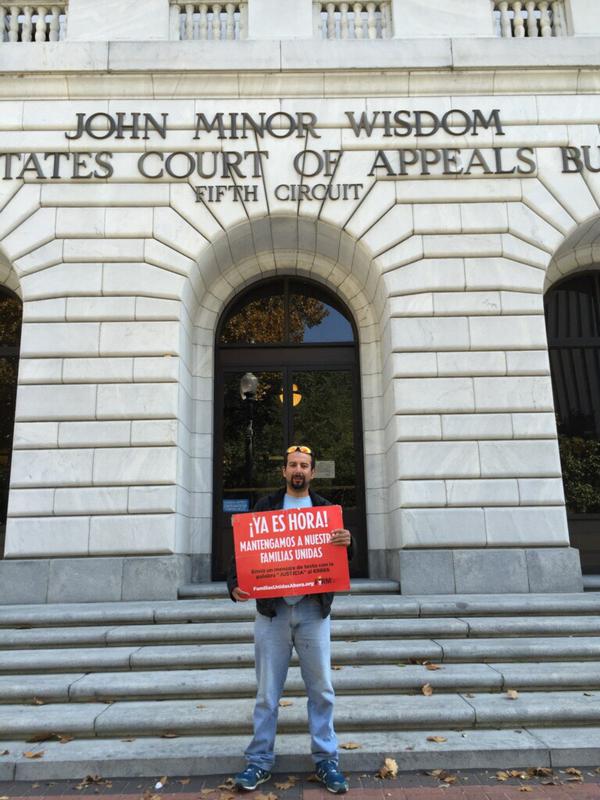
Mauricio Jiménez, the author (photo via Make The Road NY)
I came to the United States more than twelve years ago from my home in Ecuador. I had to leave my country, because, as a journalist who had written about criminals, I feared retaliation. Living here—first in Washington, D.C., and now in New York—hasn't been easy. In that time, I've been undocumented, experienced and witnessed employers stealing immigrant workers' wages, and seen—time and again—the injustices that immigrants face in this country.
Because of my experiences, I decided to join the fight for the rights of immigrants and workers. In recent years, I've joined my fellow immigrants to demand justice at the local, state, and federal levels on issues including wage theft, the minimum wage, and immigration reform.
This week, I've traveled to New Orleans to join immigrants from around the country to denounce another grave injustice against our community, which has serious effects in New York: a federal court is stalling on ruling on President Obama's immigration relief program, Deferred Action for Parents of Americans and Lawful Permanent Residents (DAPA). In response, immigrants like me from around the country are fasting this week to demand that the 5th Circuit rules quickly so that millions of immigrants can get the relief they need. We are now in the eighth day of our fast.
Last year, President Obama announced the DAPA program and related forms of immigration relief, which would benefit millions of immigrants by enabling them to come out of the shadows, get work authorization, apply for driver's licenses, and live without the fear of being separated from their families.
Since then, anti-immigrant Republican politicians filed a lawsuit to stop DAPA from taking effect, and they intentionally filed it in one of the most conservative courts—and appellate jurisdictions—in the country. Now, the 5th Circuit Court of Appeals appears to be playing a cynical political game and delaying issuing its ruling so that, if it rules against DAPA, the Department of Justice will not be able to have its appeal heard by the Supreme Court before the 2016 elections.
In other words, far-right judges are playing along with far-right politicians to prevent immigration relief from taking effect. The result is simple and disastrous: if they do not issue their decision immediately, millions of immigrant families will remain at risk of being torn apart, instead of living with the peace of mind they need.
This is personal for me and my community. For my family and friends, DAPA would make an enormous difference. We will not stand by idly and permit a court to keep our families in limbo. This week, we are showing that we are willing to put our bodies on the line to ensure that justice is done.
The Court must rule immediately so that the immigration relief provided by DAPA can move forward. We're going to continue fighting for DAPA until it's a reality, and then we will continue the fight for immigration reform that provides a path to citizenship for all 11 million undocumented immigrants, 500,000 of whom live in New York City. We will not stop fighting until we win.
***
Mauricio Jiménez is a Board Member of Make the Road New York, the largest grassroots community organization in New York offering services and organizing the immigrant community. On Twitter: @maketheroadny.
There is Nothing Innovative About Displacement

Industry City courtyard development (photo: Industry City on Instagram)
Sunset Park is at a crossroads. With one of the city’s few remaining industrial waterfronts in a heavily, working-class Latino-Asian neighborhood, its development looms large in shaping the future of New York City and, dare I say, the city’s soul.
Since the March announcement of a $1 billion investment by Industry City’s owners – a consortium of commercial real estate titans - the most dramatic changes along the waterfront have not been the building upgrades, bicycle racks, summer dance parties, or high-end artisanal purveyors. Rather, it is the stupefying number of speculative sales of industrial real estate.
Jamestown Properties is working hard to rebrand Industry City as a site for cutting edge, modern manufacturers in technology, media, design, and high-value added fashion and food production. The developer is working to placate community concerns that the Williamsburg experience of massive displacement and gentrification will not be repeated.
To this end, Jamestown Properties announced the establishment of an “Innovation Lab” in collaboration with CUNY; Southwest Brooklyn Industrial Development Corporation, which manages Sunset Park’s Industrial Business Zone; and several community non-profit social service and workforce organizations. Largely funded by public dollars, the Innovation Lab seeks to connect the neighborhood’s immigrant, non-English speaking labor force with low levels of formal education to the innovation economy.
While Andrew Kimball’s success at the Brooklyn Navy Yard should reassure us that his expertise is preserving and promoting industrial jobs and small businesses, Mr. Kimball’s employer is no longer a non-profit organization that manages city-owned properties.
The redevelopment of Industry City is not about modern manufacturing. Industry City is a commercial real estate venture and its rezoning proposal will make that crystal clear. Most of Industry City’s 16-building complex is in a heavy manufacturing M3-1 zone which prohibits retailers and hotels (unlike light manufacturing M1-1 zones). Industry City’s “unprecedented” development proposal entails designating a “special innovation zoning district” to permit a hotel, university facility (some say dormitory), conference center, and retailers.
Industry City’s consortium of owners has hired Fox Rothschild LLP to prepare its rezoning proposal. A website search of Fox Rothschild LLP’s recent projects lists one for New York City – Ian Schrager’s ultra-luxury, condo-hotel at 215 Chrystie Street on the Lower East Side.
Referencing the area’s industrial past, Schrager describes his 28-story, Public Hotel project as “refined gritty” and “tough luxe.” While one journalist described this branding as “enough to make you lunge for the barf bag,” the transparent and cavalier manner in which the lives, experiences, and neighborhood spaces of an everyday public, made up of working-class people and communities of color, are erased and then commodified for a new “public” elite is astounding.
Fox Rothschild LLP secured the necessary permits and zoning changes for its client’s “refined gritty” condo-hotel project on a former urban renewal site.
Mr. Kimball’s participation in numerous real estate conferences, including the Commercial Observer’s recent “Brooklyn’s Renaissance” event held at Industry City, has helped fan real estate speculation and small business displacement in industrial Sunset Park.
A late September Crain’s New York Business article announced the sale of two Sunset Park warehouses by New Jersey-based Hampshire Companies. Approximately two years ago, Hampshire Companies purchased the pair of buildings from Brooklyn Commercial Realty Corporation and Commercial Associates LLC for $18.5 million dollars.
At the time of the sale in June 2013, based on my research of the New York State Department of Labor’s database of registered apparel contractors and manufacturers, there were 35 garment shops located at 341 39 Street employing hundreds of workers. These small businesses included Sew Wonderful US Inc., NYC Fashionwear Inc., and MM Pleating & Sewing Inc. Today, Hampshire Companies is selling the “warehouses” for $50 million dollars having made no physical improvements or changes except for the displacement of numerous small business tenants and their employees.
The Hampshire Companies is marketing the pair of industrial buildings, which are located a few blocks away from Industry City, “as conversions to hip, creative office space or residential units.” In addition to Industry City, there are now several new property owners in Sunset Park’s industrial waterfront anticipating a rezoning to commercial and possibly, residential uses. Sunset Park’s working waterfront is being eviscerated by real estate speculators who see great profits in branding the industrial infrastructure as part of an innovation economy district.
In this hyped real estate context, Mr. Kimball will go to extremes to portray Industry City as a site of modern manufacturing. For example, the Brooklyn Flea and Smorgasburg are great additions to Industry City because, according to Mr. Kimball, they have long-served as “a platform for Brooklyn’s makers.”
Sunset Park is at a crossroads and its future depends on Mayor Bill de Blasio and Deputy Mayor Alicia Glen recognizing that protecting industrial and maritime-related jobs and land uses are as critical as affordable housing in sustaining the vibrant, diverse neighborhoods that have always made New York City a place of possibilities for working-class families.
While “Brooklyn players (were) mingling and gnoshing on a lucrative breakfast spread” at the Brooklyn Renaissance event at Industry City, UPROSE and Protect the Working Waterfront Alliance were organizing to save Sunset Park because there is nothing innovative about displacement.
***
Tarry Hum is a professor at the City University of New York and author of Making a Global Immigrant Neighborhood: Brooklyn's Sunset Park.
***
Have an op-ed idea or submission for Gotham Gazette? E-mail editor Ben Max: This email address is being protected from spambots. You need JavaScript enabled to view it.
The Right Plan for Addressing the Landmarks Backlog

The Brooklyn Bridge, in distance, & The Manhattan Bridge (photo: Daniel Avila/NYC Parks)
Meet Backlog95.
Clunky operating system?
Nope – it's a list of 95 historic places before New York City's Landmarks Preservation Commission.
Commission Chair Meenakshi Srinivasan thinks it's time to make some decisions on which will be given historic landmark status – a reasonable position, as some items have been under the agency's consideration since John Lindsay was mayor.
To clear the pile up, Srinivasan put Backlog95 up for debate for the first time in decades. The list includes icons like the Pepsi Cola sign, Green-wood Cemetery, and Coney Island's charming Art Deco Pumping Station.
Beginning at a packed hearing, landmarks commissioners began reviewing research, listening to testimony, and making decisions based on the merit of each property. The plan is to revisit the entire list at the beginning of 2016, with the end goal of clearing the decks of all outstanding properties – one way or another – by December 2016.
But Srinivasan's plan has competition.
Earlier this year, City Council Members David Greenfield and Peter Koo proposed a new bill – known as Intro. 775 – that would clear the backlog using restrictive new rules, including an 18-month timeline and a five-year moratorium on resubmissions to the Commission.
There are consequences to this approach:
Historic landmark designation is a meticulous process, and a timeline encourages bad actors to delay progress in the hopes of dodging landmark designation.
Even the most obvious landmarks can take time to properly research and consider. But under the bill's current timelines and given the way their process unfolded, both Grand Central Terminal and Radio City Music Hall would have exceeded the window for consideration and would have been sent to the back of the class for five years before landmark protection could be reconsidered.
What sounds like a momentary inconvenience is actually a long time to keep the bulldozers at bay. If we are not careful, we could easily lose places essential to our city's history and future.
The bill's proposed moratorium is even more dangerous, as it places the structural integrity of deteriorating buildings at risk for five years once the clock runs out. That's a lifetime for any building facing our city's brutal winters, especially when the Landmarks Commission has no power to ensure historic buildings are protected from the elements.
"This bill seeks to clear the decks – in the crudest possible way – for the destruction of historic fabric," testified one Lower Manhattan resident at a marathon September 9 hearing. Three-quarters of the hundred other speakers agreed.
Nobody wins when the Commission drags its feet. But if the City Council overreacts, New Yorkers risk losing the places and spaces that make our city great.
That's why we support Srinivasan's fix. It's the best upgrade for Backlog95 – and for the city we love.
***
Simeon Bankoff is Executive Director of the Historic Districts Council. The organization is on Twitter at @HD_NYC.
***
Have an op-ed idea or submission for Gotham Gazette? E-mail editor Ben Max: This email address is being protected from spambots. You need JavaScript enabled to view it.
Albany Transparency and the MTA Funding Deal: Show Us Our Money

Down a dark tunnel (photo: MTA/Patrick Cashin via flickr)
The big news is that Governor Cuomo and Mayor de Blasio have stopped fighting over who should pay what, and reached a deal to close a huge gap in the MTA's vital $26 billion five-year capital plan. But their story of political conflict and compromise obscures a crucial fact: it's not their money, it's ours. Going forward the public has the right to know exactly what the governor and mayor intend to borrow and spend in our names.
Fully funding the MTA is a must, but New Yorkers are going to be stuck with the bill for the new subway trains and buses long after the governor and mayor have moved on. We need to know what they are getting us into.
So far, Governor Cuomo has refused to reveal a specific funding source for his pledge of an additional $8.3 billion, saying only that the money is coming from "state sources." Based on the State's available sources of funding and borrowing, this means it is highly likely that the State will create a mountain of new debt that the MTA and transit riders will be ultimately responsible for.
The governor has said he does not want to raise new taxes and will not push for the Move NY road pricing plan. The State's bank settlements are already spoken for, and the General Fund will not have anywhere near $8.3B in cash to spend on the MTA over the next four fiscal years, especially if Upstate demands equal funding for its roads and bridges. That leaves borrowing.
The State does almost all of its borrowing by getting public authorities, like the MTA, to borrow on its behalf. The State does this to avoid debt limits and public votes. Therefore, by far the most likely way Governor Cuomo will pay for his $8.3B pledge is by having the MTA borrow the money by selling bonds which the State will pledge to pay for. This is called a "service contract bond."
The key thing about service contract bonds is that the State's commitment to pay for them is not legally binding, and the MTA and transit riders are ultimately responsible for paying bondholders if the State reneges on its commitment. If the state does renege on some or all of the promised payments, the MTA and transit riders could be left holding a very large bag: paying back $8.3B in bonds will cost roughly $500 million a year for 30 years.
Unfortunately, Governor Cuomo has a bad track record with MTA service contract bonds. Since 2013, he has reneged on $70 million in State payments for Pataki-era MTA service contract bonds, and his latest budget calls for reneging on another $60M. Instead of the promised State funds, the Governor used MTA funds for the debt payments.
Admittedly, this is a modest amount of money given the MTA's giant budget, but it shows how easy it is for a Governor to break an old promise. If the Governor is reneging on debt payments in today's prosperous times, what happens during bad times over the next 30 years?
Government transparency can be an abstract idea, but for transit riders it really matters right now. The MTA will borrow billions more to pay for its share of the capital plan, and its debt payments are already a dangerously high share of its operating budget. This debt has translated into more expensive MetroCards and an increasing burden on everyday New Yorkers.
The stakes are high and New Yorkers deserve to know from Governor Cuomo, Senate Majority Leader Flanagan and Assembly Speaker Heastie what the risks and benefits are of service contract bond borrowing and other financing options for the MTA capital plan --- after all, it is our money.
***
John Kaehny is the executive director of Reinvent Albany.
***
Have an op-ed idea or submission for Gotham Gazette? E-mail editor Ben Max: This email address is being protected from spambots. You need JavaScript enabled to view it.
The 'Three-Quarter House' System We Need to Embrace

A ground-breaking (photo via @NYCMayorsOffice)
New York City is in a housing crisis, you've surely heard, or seen, or felt. Rents are headed skyward, the homeless shelters are bursting at the seams, and formerly poor and neglected neighborhoods are filled with bearded hipsters drinking craft beers.
For poor people, housing is almost impossible, but for persons in recovery from addiction—or on parole or probation—the challenges are multiplied many times. Felons cannot live in public housing, for example, and the job prospects for someone with a criminal record are very limited. Sobriety is difficult to maintain in the best of circumstances, and stability and peer support are essential.
So what's a poor addict to do? So-called "three-quarter houses" have risen to meet the demand for housing but they are, in some ways, worse than living on the streets. Three-quarter houses can be loosely defined as shared housing for persons in recovery who agree to split expenses and live without illegal drugs or alcohol. They are less restrictive than halfway houses which have strict rules, are usually for felons only, and have paid staff from a managing agency (often the Department of Correction) onsite 24 hours per day.
In New York City, the variant on three-quarter houses that has taken root is unusually predatory and grim. The New York Times has published several articles on these flophouses—a more apt description—where slumlords gouge recovering addicts and former prison inmates for their welfare benefits, house them six to a room and take kickbacks from the treatment programs that the men (mostly) are required to attend.
When a resident completes a drug program they are urged to relapse and be readmitted to a treatment facility, so the landlord can continue getting his kickback. The directors of Narco Freedom, a major provider of substance abuse treatment and three-quarter housing with multiple sites in New York City, have been arrested and indicted on medicaid fraud, and the organization is teetering on the edge of bankruptcy.
The city made a public relations show of closing down a few of these unlicensed and unregulated abominations, but there are hundreds, according to estimates. And there is an endless supply of people seeking cheap and sober housing; the War on Drugs has not abated the number of sufferers but has produced a bumper crop of convict-addicts seeking shelter as they stream out of the jails and prisons.
An estimated 25,000 people are released from New York prisons each year and another 81,000 from New York City jails. Without adequate housing, an addict's chances of staying sober and avoiding criminality are drastically diminished.
There is, however, another model for three-quarter houses that works - and I know from having lived in one.
I spent two years—after a long saga of depression, addiction, incarceration, and treatment—in a three-quarter house run by the non-profit Oxford House group, which manages thousands of such houses nationwide.
Each Oxford House is run on a cooperative basis by its residents. Paid staff manage the start-up phase of each house by finding a rental unit, negotiating a lease, making the upfront payments, and finding the first cohort of tenants. Once established, the tenants pay equal shares toward the rent and utilities, set house rules, assign chores, choose officers, and manage the house on a democratic basis.
Attendance at a treatment program (of the tenant's choice!) or at 12-step groups is a requirement, and if a person relapses the result is an immediate eviction.
The Oxford model is well-established in several states. In New Jersey, for example, there are about 120 houses but it has not caught on in New York (the website lists 17 total houses statewide).
The basic model is simple and any not-for-profit serving these populations could start a three-quarter house by investing a few months of rent upfront. In fact, payback of the initial investment, through small monthly payments from residents, can be part of the model so it need not cost the sponsoring agency a dime.
The basic model can be modified depending on the sponsoring group and the needs of the particular population. For example, the monthly welfare allowance for shelter is reported to be $215 per month per person. It is a low number and it may not be possible to operate a sober house with, say, ten residents, a typical number for the private houses, if all are on welfare. It is likely that a mix of private, paying residents and welfare residents would be required. Otherwise, a small subsidy from the sponsoring agency might be necessary.
Three powerful and intertwined forces—the housing crisis for the poor, the depopulation of the prisons, and the substance abuse epidemic—have combined to create a demand for affordable housing for these often comingled groups. Three-quarter houses, managed responsibly, are one of many answers that are needed.
***
Christopher Beall currently works for the Osborne Association, a nonprofit criminal justice reform group in the Bronx.
***
Have an op-ed idea or submission for Gotham Gazette? E-mail editor Ben Max: This email address is being protected from spambots. You need JavaScript enabled to view it.
A Better Way to Fund the MTA
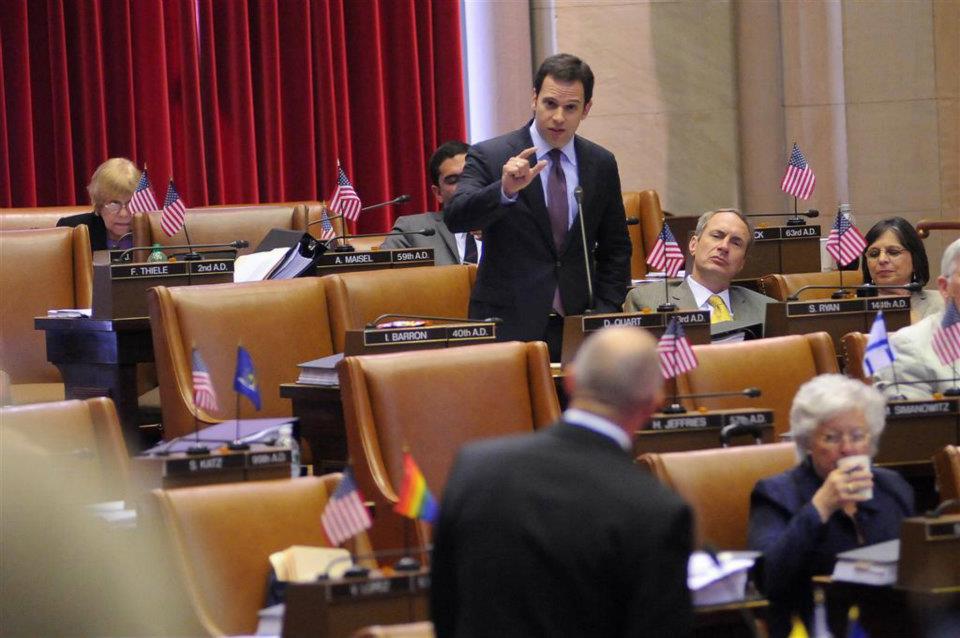
Assembly Member Quart, the author (photo via Facebook)
No New Yorker has been able to miss the recent back-and-forth over MTA funding. Once again, we are trapped in an unwinnable argument. Whose responsibility is the MTA capital plan? Should New York City contribute more funding? Or is it the state's responsibility, since the MTA is a subsidiary of state government?
The conversation has devolved into threats against the New York City transit system and, as of yet, yielded no real solutions. In fact, this debate is exactly the problem. It completely misses the point.
We're funding the MTA Capital Program all wrong.
Nationally, New York City's transit system is unique. It is what allows us to be a city that functions with aberrantly low levels of car ownership. We are 'the city that never sleeps' because of our round-the-clock transit system. Without it, the gears of our city simply won't turn. And without the economic activity that is driven by transit in New York City, the rest of the state suffers as well. The entire state is dependent on a strong city transit system.
Framing the capital funding process as a question of city dollars versus state dollars is just obfuscation. The critical truth about all of these dollars is that they're not guaranteed. The MTA Capital Program, which pays for upkeep and expansion of our transit system cannot count on a single dollar of funding from dedicated budgetary revenue streams.
This means that every five years, we go through through the same argument we are having this year - quibbling over who will pay for the capital plan while our transit infrastructure deteriorates. Our subways and buses are more crowded, less punctual, and far more likely to break down than they were just a few years ago.
Without significantly more funding, these problems will only get worse.
There's an alternative, though, and it's one that we've already seen work. Across the ledger, the MTA operating budget benefits from a number of dedicated revenue streams, including the mortgage recording tax and the commuter tax. These funds are statutorily required to be used for their stated purposes.
We must expanding this idea to the capital side. In order for New York City to continue being a city that drives the state's economy, we need to ensure the upkeep of our transit system, but we also need to continue expanding it, to make sure that every part of the city that never sleeps is equally able to access transit.
It's time to put a stop to the budget dance. It's time to stop enabling unproductive arguments that distract from the real issues. It's long past time for the MTA capital program to be supported with statutory, dedicated, un-sweepable revenue streams that will allow maintenance and improvement of our subways and buses, the critical infrastructure that keeps New York City moving and drives the New York State economy.
***
Dan Quart is a New York State Assembly member representing the East Side of Manhattan. He is on Twitter @DanQuartNY.
***
Have an op-ed idea or submission for Gotham Gazette? E-mail editor Ben Max: This email address is being protected from spambots. You need JavaScript enabled to view it.
Shooting Deaths Recall New York's Long History of Trying to Curb Gun Violence
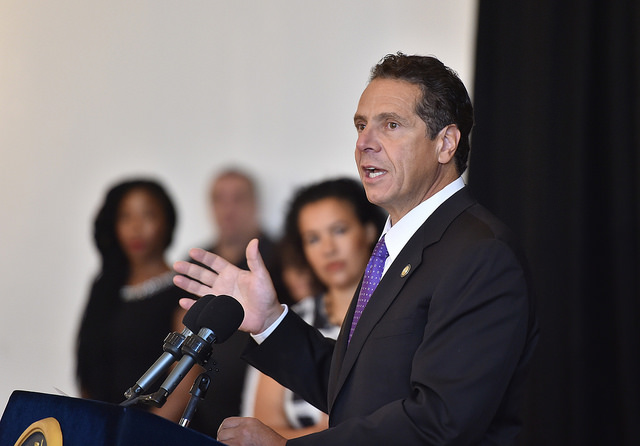
Gov. Cuomo (photo: Office of the Governor - Kevin P. Coughlin)
New York has been shocked by gun violence for a long time.
Recently, on September 7, Carey Gabay, former assistant counsel to Governor Cuomo and a deputy counsel at the Empire State Development office in New York City, was shot in the head near the site where the West Indian American Day Carnival parade was scheduled to kick off a few hours later. He died of his wounds on September 16.
"We must act and we must say we're not going to take it anymore," Governor Cuomo said at Gabay's funeral service. "The killing has to stop."
Since the shooting, Cuomo has called attention to the Secure Ammunition and Firearms Enforcement (SAFE) Act that he pushed through the legislature early in 2013, in the wake of the Sandy Hook Elementary School shootings in Connecticut. Gun rights activists continue to fight that law. Cuomo consistently declares it a national pacesetter and insists that federal action is needed.
Cuomo repeated his appeal after the October 1 killing of nine people by a gunman at a community college in Oregon. Calling gun violence "a sickness that continues to claim innocent lives and threaten our communities" while "our elected officials in Washington continue to sit on their hands." Guns continue to flow into New York from states with laxer gun laws, the governor added.
Today, New Yorkers continue to argue over the SAFE Act and the gun violence that plagues major cities, while state gun-permitting laws are complicated. New York's gun policies began over a century ago.
On August 9, 1910, New York City Mayor William J. Gaynor, who had taken office in January, was waiting to board the ship SS Kaiser Wilhelm der Grosse at the terminal in Hoboken for a trip to Europe when he was approached by James J. Gallagher, who had been discharged from his position as a New York City dock night watchman earlier in the year for dereliction of duty. Repeated letters to the Mayor appealing for reinstatement got no results.
Gallagher walked up to the mayor and shot him in the neck. Sanitation commissioner William Edwards, who had been there to see the mayor off, was also wounded. Gaynor's aides and bystanders wrestled the would-be assassin to the ground. A New York World photographer happened to be on the dock for what he had assumed would be a routine photo of the mayor. Instead, he snapped a picture an instance after the shot, capturing a bloodied Gaynor reeling from the shot. The photo was soon on the front pages of city newspapers and was widely reprinted. It was a graphic representation of the horror of completely unexpected gun violence.
Gaynor survived but the bullet lodged in his neck and could not be removed. He recovered slowly. It caused him pain and discomfort until his death in 1913.
"I shot him because he robbed me of my position," Gallagher told police who arrested him. "He could have put me back to work and he wouldn't."
At his arraignment, the prosecutor asked Gallagher if he had read about the assassination of other public men. He replied he had read about the assassination of President William McKinley in 1901. "Do you believe in it?" asked the prosecutor. Gallagher's chilling reply was: "Yes, if you have a grievance and can't right it any other way."
Apparently because of the mayor's slow recovery, Gallagher was not tried for shooting him but was sentenced to 12 years for shooting Commissioner Edwards. He died in prison in 1913.
David Graham Phillips was a prominent novelist living in New York City in the early 20th century. Phillips' novels often commented on social issues of the day and frequently chronicled events based on his real-life experiences as a journalist before he took up writing fiction. He wrote a series of articles entitled "The Treason of the Senate" in Cosmopolitan in 1906 that exposed corruption in the Senate. Phillips was something of a public figure, often seen strolling on New York sidewalks.
On January 23, 1911, Fitzhugh Coyle Goldsborough, an eccentric violinist and music teacher, gunned Phillips down outside the Princeton Club on the north side of Gramercy Park. Club members heard the assailant cry out "I've been waiting for six months to get you" and then "Here you go!" as he shot the novelist six times. He then muttered "Here I go!" before shooting and killing himself. Phillips succumbed to his wounds the next day.
Police searched Goldsborough's apartment; from diaries and papers they learned he had become fascinated with one of Phillips' novels, "The Fashionable Adventures of Joshua Craig." He believed it drew on Goldsborough family history and portrayed it in an unflattering way, and that the novelist had modeled the central character on Goldsborough's sister. He also believed Phillips could read his mind.
The shootings of Mayor Gaynor and David Graham Phillips provoked public outrage. But it was a rising tide of street gun violence that led to legislative action.
Timothy Sullivan, a Democratic state senator from the Bowery area of Manhattan, was appalled at the Gaynor and Phillips shootings. But he was even more alarmed about a rising tide of gang-related shootings in his district.
Sullivan, often known by his nickname "Big Tim," was unlikely to be mistaken for a do-good reformer. He was a Tammany Hall regular who was involved with gambling, prostitution, and corruption. But he was also concerned with the welfare of his constituents and Tammany Hall itself was becoming more reform-minded. In 1911, Robert F. Wagner was Speaker of the Senate and Alfred E. Smith was majority leader in the Assembly. They were both Tammany men but favored progressive policies.
Sullivan introduced a bill in the 1911 legislature to require licenses for New Yorkers to possess firearms small enough to be concealed. Possession of such firearms without a license was defined as a misdemeanor, and carrying one was defined as a felony.
Sullivan explained that "gun toters" (as the press often called gunmen) fell into three categories. The first was professional criminals. The second consisted of people who are deranged or commit gun violence in fits of rage. His law would help in those areas, he said.
But, Sullivan was more concerned with a third category, "...young fellows who carry guns around in their pockets all the time not because they are murderers or criminals but because the other fellows do it and they want to be able to protect themselves....those boys aren't all bad but they're in a mighty bad way. Just carrying their guns around makes 'em itch to use 'em."
The bill was opposed by some gun owners and gun manufacturers. One upstate senator told Sullivan that "your bill won't stop murders. You can't force a burglar to get a license to use a gun." Others warned that people would get guns from other states. But the bill found wide support among concerned New Yorkers in both parties who had been shocked by the assassination of a renown novelist and the assault on their city's chief executive.
Republican District Attorney (later Governor) Charles Whitman said that "carrying a weapon is an invitation to a crime. Reduce the weapons carried and you will reduce crimes of violence. There isn't any debating that point."
The Sullivan Act passed easily. It was challenged in court and debated for more than a century, but its basic provisions are still in place.
Gunfire that is completely unexpected is a frightening specter. Shortly before the shooting, a constituent had warned Mayor Gaynor against going around the city unescorted. "I do not think anyone would do me harm unless he was a lunatic," he responded, "and it is hard to guard against lunatics."
"I'm governor of New York and there's nothing I can say and there's nothing I can do," Governor Cuomo said, after visiting Carey Gabay at Kings County Hospital Center before he died. "Sometimes, it just hurts."
Yet the murder of the governor's aide and the killings in Oregon are certain to provoke more debate over gun violence in New York and elsewhere, and what can be done to curb it.
***
Dr. Bruce W. Dearstyne is the author of the book The Spirit of New York: Defining Events in the Empire State's History, published in 2015 by SUNY Press.
***
Have an op-ed idea or submission for Gotham Gazette? E-mail editor Ben Max: This email address is being protected from spambots. You need JavaScript enabled to view it.
Next Steps After Eye-Opening NYPD Inspector General Use-of-Force Report
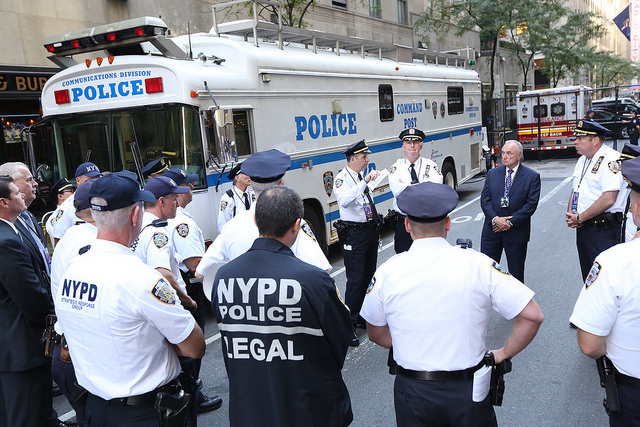
(photo via NYPD on flickr)
Officer James Frascatore is working behind a desk after assaulting James Blake last month. But if history is a guide, there's far too strong a likelihood that he won't be held accountable for his action.
That's the key finding of the report released yesterday on use-of-force by the NYPD Inspector General: From 2010 to 2014, the NYPD failed to impose discipline in 35.6 percent of cases with substantiated evidence of excessive force. If we are honest, we know that this problem pre-dates Commissioner Bratton and this Administration, but we must rightfully look toward the Commissioner and the Mayor to take corrective action.
The 62-page report digs deeply into NYPD use of force, with a strong set of recommendations for how to fix the problems identified.
We are pleased to see Commissioner Bratton quickly adopt a number of the policy recommendations in the report, including a far more rigorous tracking system for use-of-force incidents, clearer definitions of use of force, better training, and an annual use-of-force report.
These are necessary and important steps in the ongoing effort to improve police-community relations. They must help officers better understand essential procedures and eliminate instances of excessive force like those that resulted in Eric Garner's death and James Blake's assault.
The key remaining issue, though, is accountability when excessive force is used. The NYPD Inspector General's report identifies this as a clear area of concern, and calls for specific and appropriate reforms.
Commissioner Bratton has indicated that he is creating an internal unit to monitor officers with frequent complaints against them and he has voiced his commitment to work more closely with the CCRB on its disciplinary recommendations.
At the same time, however, there is still no explicit acknowledgement of the reality that the IG's report demonstrates clearly: in far too many cases, NYPD officers have faced no accountability for excessive use of force. The real proof of effective reforms will be seen when there are fewer officers inappropriately using force and when officers who use excessive force are held accountable for their actions.
That is why establishing by law an NYPD Early Intervention System for overly-aggressive police officers, as proposed by Council Members Williams and Garodnick, is so important. By establishing a system to quantify excessive force complaints, our city can better understand which officers may be prone to excessive force and who may need additional training, supervision, or other consequences.
We look forward to working with Commissioner Bratton to codify by law the early intervention work he is doing, to consider other legislation before the City Council, including the Right to Know Act, and to adopt the remaining recommendations in the Inspector General's report. While the issues at hand are decades old, span many police commissioners, and are not confined to New York City, there is real opportunity for us to lead the way, and to do so now.
This report - data-driven, thoughtful, and constructive - demonstrates the value of the Office of the NYPD Inspector General, just as we hoped when we passed the Community Safety Act in 2013. In a short time and to the contradiction of critics, the NYPD IG has already made real contributions toward improving public safety and advancing civil rights.
***
Jumaane D. Williams and Brad Lander are New York City Council Members from Brooklyn who co-sponsored Local Law 70 of 2013, which established the Office of the NYPD Inspector General.
***
Have an op-ed idea or submission for Gotham Gazette? E-mail editor Ben Max: This email address is being protected from spambots. You need JavaScript enabled to view it.




